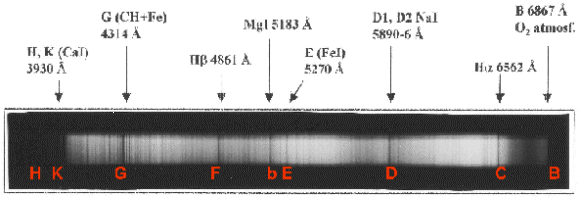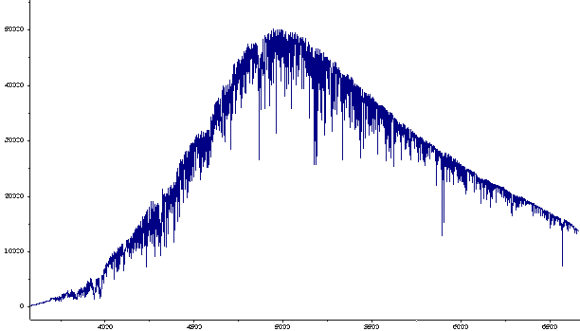NORMAL STARS SPECTRA
Spectral classes:
O
- B
- A
- F
- G
- K
- M
Type G stars
The temperature in the atmosphere of G type stars ranges from 4800 to 6000 K for dwarfs
and from 4200 to 5400 K for supergiants.
In the spectrum of G stars, if compared to K star's, the neutral metal lines weaken and
the ionized metals lines appear .
Hydrogen Balmer lines are also among the main spectral features because the higher
temperature increases the population of the second Bohr orbit.
It should also be noticed that among late G subclasses, the H and K Ca II absorbtions
reach their maximum strenght.
Subclasses are determined from the ratio between the intensity of H d
and Fe I 4144 ┼ lines.
Moreover in G class survive the strongest molecules (CN, CH). At higher temperatures all of them
are dissociated (except for CH that we can find also in late F stars).
Among G type stars we find:
Sun (G2 V), Capella (G0 III + G5 III),h
Boo (G0 IV), V509 Cas (G4 Ia), a Cen A (G2 V), 9 Ceti (G2 V),
r Crb (G2 V)
Without any doubt the sun is the brightest and easy to observe G star!
It is precisely classified as a G2 V star, thus a main sequency dwarf with 5800 K surface
temperature.
Because of its brightess it is often used as a source for reference spectrum.
The discoverer of dark lines across the visible solar spectrum was William Wollaston
in 1802 that described his experience of dispersion of solar light throught a prism in the paper
"A method of examining refractive and dispersive powers by prismatic reflections"
where he made the hypotesis that dark lines are the boundaries between colors.
Some years later, the great optician Fraunhofer, improved the method of prism dispersion
putting the prism in front of a small telescope.
In the visible range he was able to see more than 500 lines and indicated the strongest
with a roman letter. Many of these letters, since then, entered in the common spectroscopic
gergon (see picture 1).
Picture 1: Solar spectrum recorded on TP 2415 with spectral resolution of about 5 ┼.
The continuum component of the radiantion emitted by the sun can be approximate to a
black body emission.
From the Wien law we can obtain the wavelenght of the emission maximum
l max=2898/T = 0,500
mm that give
5000 ┼ (if T is expressed in K).
Picture 2: Solar spectrum recorded with 0,7 ┼ resolution on CCD. The spectrum can be
seen in details with the main lines identification, choosing the spectral range of
interest in the following table.
| Spectral range |
Main bands and lines |
| 3700 - 3975 ┼ (clic) | H and K Ca II lines |
| 3975 - 4200 ┼ (clic) | H d |
| 4150 - 4420 ┼ (clic) | CH "G" band |
| 4400 - 4675 ┼ (clic) | metal lines Fe I, Ca I, Ba II, Sr I ů |
| 4675 - 4875 ┼ (clic) | H b |
| 4855 - 5155 ┼ (clic) | H b ,Fe I, Fe II, Ba II , Ti ... |
| 5155 - 5460 ┼ (clic) | triplet Mg "b" |
| 5460 - 5730 ┼ (clic) | metal lines Fe I, Fe II, Mg I ů |
| 5725 - 6070 ┼ (clic) | doublet Na "D" |
| 6050 - 6355 ┼ (clic) | metal lines Ca I, Fe I |
| 6350 - 6775 ┼ (clic) | H a |
Goto other spectral classes:
- O
- B
- A
- F
- G
- K
- M
|



